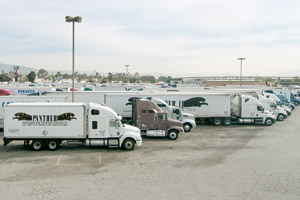Mobile Apps, Reserved Spaces Help Drivers Locate Available Parking

This story appears in the Aug. 22 print edition of Transport Topics.
Industry organizations, major truck stop chains, government officials and a Silicon Valley startup are all attempting to help truck drivers with one of their most pressing challenges today — finding a place to park.
These efforts include mobile applications that point drivers toward available spaces and services that allow them to reserve parking spots for a fee.
The truck parking issue presents more than a minor inconvenience, because several other industry problems pile up when truck drivers cannot find a place to park. Hours of service violations increase, and the steps drivers take to avoid such violations may adversely affect efficiency and service.
“About once or twice each month, I’ll hear from a driver that his e-logs hours-of-service violation happened because he couldn’t find parking,” said Jim Burg, president of James Burg Trucking Co. in Warren, Michigan. “The driver made it to a rest area or truck stop in time but didn’t find any open parking spaces, so he was forced to drive further in violation in order to find a place to park.”
Mike Wheelock, operations team lead for the contract carrier division at Interstate Distributor Co., heard from one of his drivers that parking spots start filling up at about 4 p.m.
“That explains why drivers who have three or four more hours to keep driving sometimes stop early,” Wheelock said. “They get stressed about finding a safe place to park, so they can’t fully utilize their hours. If drivers are already looking for a place to park at 4 in the afternoon, you know that this is a serious issue. It’s a concern to us that they have to hunt around for a safe place to park.”
The parking problem is “huge, and it’s not going away,” said Dan Murray, vice president of research for the American Transportation Research Institute.
Truck parking ranked as the No. 2 issue for truck drivers and the No. 5 concern for carriers in ATRI’s 2015 survey of the industry’s top issues.
The government-mandated move to electronic logging devices threatens to make matters worse.
“When the ELD mandate rolls out in December of 2017, it will put more pressure on drivers around parking,” said Wheelock, of Interstate Distributor. “They’ll have to be more careful about getting to a parking place in time.”
Interstate Distributor, based in Tacoma, Washington, ranks No. 67 on the Transport Topics Top 100 list of the largest for-hire carriers in the United States and Canada.
Although ELDs are expected to put more pressure on drivers because paper logs can be falsified in ways that electronic logs cannot, that is only part of the story.
“People sometimes presume that some fudging occurs with paper logs,” Murray said, “but keep in mind that regardless of that, paper logs record time in 15-minute blocks. At 60 mph, a 15-minute block gives you a 15-mile window, which is sort of an insurance policy when you’re looking for a place to park. That’s one reason things will be very different under ELDs.”
New efforts to help drivers find parking include the Park My Truck mobile application from the Truck Parking Leadership Initiative, an effort led by the Natso Foundation, ATRI and American Trucking Associations.
“We are reaching out to anyone who provides truck parking,” said Tiffany Wlazlowski Neuman, senior director of communications and public affairs for Natso, which represents truck stop operators. “Anyone who provides truck parking is able to participate.”
The app is in the final stages of development and is expected to be released soon.
Meanwhile, drivers currently have the option of reserving parking spaces at certain truck stops in the Pilot Flying J and TravelCenters of America chains for a fee.
“The cost of reserving a parking place varies based on location, availability and time of reservation,” said Tom Liutkus, senior vice president of marketing and public relations for TA.
A PFJ spokesman said that at most of the locations where there is reserved parking, the fee is $12 per night, but in major metro areas the cost is $15 per night.
Some organizations are using federal grants to attack the parking problem.
ATRI’s Murray said the Mid America Association of State Transportation Officials is using federal grants to build real-time parking availability systems at public rest areas. Florida also is using a federal grant for a large-scale real- time information system to track availability, he added.
In Murray’s view, this is the beginning of a large-scale effort to piece together a critical mass of public rest areas and private truck stops.
“We hope that what is starting regionally and in certain traffic corridors will eventually become a national system,” he said.
Another approach to providing drivers with location data on available parking is to tap into the collective knowledge of the drivers themselves.
Trucker Path, a Silicon Valley startup based in Mountain View, California, offers drivers a free mobile app called Trucker Path Pro, which provides a variety of information about truck stops, including reports on parking spaces.
“Trucker Path is not just an app; it’s a community, a crowdsourcing community of truckers,” said Ivan Tsybaev, Trucker Path’s CEO and founder.
He said Trucker Path’s 1.5 million downloads make it the industry’s most popular mobile app, as well as its largest crowdsourcing platform.
Drivers using the app report on their observations at truck stops and rest areas.
“Any truck stop or rest area I stop at, I always pull the phone out and report in on how much parking is available,” said Joe Schmitz, a truck driver for New Way Trucking, based in Bedford, Indiana. “I’m on Trucker Path probably 30 or 40 times a day.”
The app enables drivers to categorize parking availability at a particular stop or rest area as “red” for full, “yellow” when some parking is available, or “green” when a lot is empty. They also have the option of providing more specific comments. In addition to collecting current data from drivers, Trucker Path offers a historical perspective based on data collected over time.
“I look at the history and can see if a truck stop is usually full at certain times,” said owner-operator Ivan Sandul. “I also read the comments, because other drivers will mention numbers, such as ‘there are 20 spots in the back.’ Seeing information like this has helped me out several times.”
When truck drivers have problems finding a place to park, the immediate conclusion is that there must not be enough parking spaces.
Trucker Path’s Tsybaev questioned this assumption, saying that the data collected from drivers on the Trucker Path Pro crowdsourcing app for drivers show that some parking is generally available in most areas.
“Even when truck parking is being used most — from 11 p.m. to 5 a.m. — there is available parking close by,” Tsybaev said. “You just need the right tool to find the empty spaces,” he said.
ATRI’s Murray took an opposing view, arguing that the industry also must focus on creating more parking areas.
“First and foremost, we need more spaces,” he said. “However, until our state and federal trust funds have more resources, providing information on parking availability is our best bet.”
One focal point for the effort to increase parking capacity should be to incorporate parking into new real estate developments, said Burg, of James Burg Trucking Co.
“When something like a new manufacturing plant is being planned, I would certainly have a component of truck parking zoned into it,” he said. “Too often with new developments, trucking is the afterthought. We need to be part of that discussion early on.”




